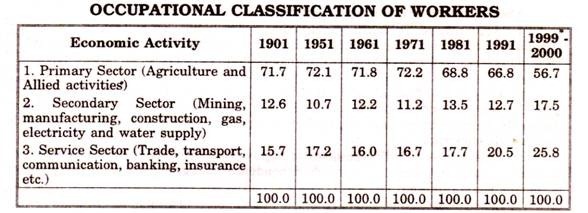Labour force is defined as those able-bodied workers in the age group of 15 to 59.
The proportion of working population to total population is called work participation rate. In Underdeveloped Countries (UDC’s) the work participation rate of labour force is low.
According to 1981 census, the work participation rate in India was 36.7 percent. In 1991, it increases to 37.7%. According to 2001 census, the work participation rate increased to 39.2 percent. It means out of our total population of 102.7 crore, about 40 crore people constitute the work force.
Similarly in 1991, out of total population of 84.6 crore, about 32 crore people constituted the labour force. We will observe how many of our labour force were employed in agriculture and how many engaged in industrial and service sector. The following table presents the comparative analysis of occupational pattern since 1901.
An in depth analysis of the table indicates that occupational distribution of India’s work force shows the backwardness of the Indian economy. From 1901 to 1970, there was no change in the occupational pattern especially in primary sector agriculture and allied activities. In 1901, 71.7% of the labour force was engaged in primary sector.
In 1971, almost the same proportion (72.2%) of the labour force was in agriculture only in 1981 there has been small decrease in the proportion of work force engaged in agriculture. In 1991, 66.8% of the labour force was employed in agriculture. A recent estimate shows that 56.7 percent of our labour forces are employed in agriculture. This slow decrease in the proportion of work force employed in agriculture in the reference of increasing population growth shows large disguised unemployment in Indian agriculture.
Another feature of the occupational structure in India is the constant stagnancy in the ratio of labour force employed in secondary and tertiary sector. 27.9 percent of the labour force was employed in secondary and tertiary sector till 1971. In 1951, 10.7 percent was engaged in industrial sector which slightly increased to 12.7 percent in 1991. NSS estimate shows that in 1999-2000, 17.5% was engaged in secondary sector. In second plan huge investment was made to industrialise economy. This had put a small effect on the occupation structure of the country.
While analysing the rate of labour employment in tertiary sector, it is found that 17.2 percent was engaged in this sector in 1951. During the period of 1st six plans the situation remained unchanged. In 1981, 17.7% was employed in tertiary sector. Only in 1991, this ratio has gone up to 20.5 percent and in 1999-2000, it increased to 25.8 percent.
ADVERTISEMENTS:
After the satisfaction of basic needs like food, clothing and shelter which directly come from agriculture and industry, people demand various kinds of services like health education, travel, transport, banking and insurance etc. With the development of a large middle class in India, the share of service sector to GDP and ratio of work force engaged in tertiary sector are supposed to increase.
Concluding we can say that there is no visible shift in the labour force from the primary to the secondary and tertiary sectors in our country during twentieth century. If we accept this hypothesis that economic development of a country is associated by a shift of the working population from the primary to the secondary and then to the tertiary sector, then it indicates the economic progress is not favourable in India.
